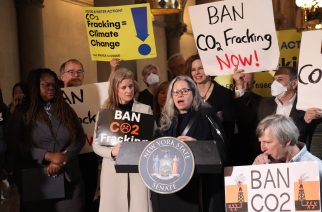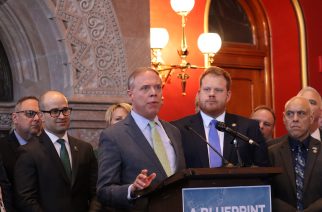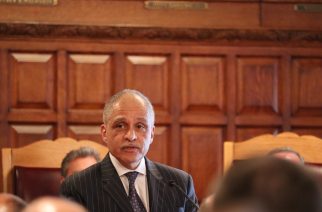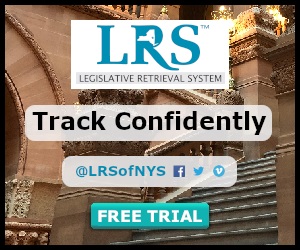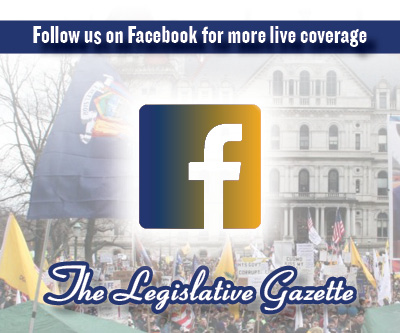
Gov. Andrew Cuomo said Wednesday that New York state will withhold funds for local governments and schools in COVID-19 cluster zones if they fail to enforce public health laws.
The state Department of Health will send a letter warning local governments in cluster zones that they will lose state funding if they fail to enforce state limits on gatherings and the closure of schools.
The letter was sent to New York City, Orange County, Rockland County, the Town of Ramapo and the Village of Spring Valley.
Cuomo also announced that DOH will send an additional letter warning public and private schools in cluster zones that they will lose state funding if they do not comply with state requirements on closure and testing.
“We know that public and private schools in the red zones are supposed to be closed. We know that there were violations where yeshivas were operating. We know there were violations where religious gatherings were happening that exceeded the guidelines. This is especially a problem in Brooklyn and Orange and Rockland Counties,” Cuomo said.
“The micro-cluster we’re focusing on is the ultra-Orthodox communities. As you know, it is still the same. The question now is enforcement,” Cuomo said.
The governor went on to thank news media outlets for covering the ongoing violations.
“WABC and N.J. Burkett, kudos to him, he did a great piece where he had a yeshiva that was operating in plain view,” Cuomo said. “Gothamist also had a piece to the same point – so kudos to them for good reporting. This is especially a problem in Brooklyn and Orange and Rockland counties.”
Of the 146 new hospital admissions yesterday, 68 of those, or 47 percent, were from several counties — Brooklyn, Queens, Rockland, Orange, and Broome — where the state is tracking recent cluster outbreak situations. New York state’s current weekly average is 123 new admissions per day. This is compared to the June average of 128 new admissions per day, 94 new admissions per day in July, and 69 new daily admissions in August.
In these “Red Zone” focus areas, the positivity rate for test results reported on October 14 is 6.29 percent – up from the 4.13 percent the day before. The “Red Zone” focus areas are home to 2.8 percent of state’s population, yet had 15.6 percent of all positive cases reported yesterday to New York state.
Listen to the audio of the governor’s conference call with reporters on October 14.
“Number one, we are sending a notification to local governments saying they must enforce public health law under Section 16. If the local government does not effectively enforce the law, we will withhold funds,” the governor said. “We’re also sending a letter to all schools in the red zones saying to them that they must be closed. If they violate the Section 16 order, we will withhold funding from the schools. This is a last and final warning.”
Statewide, COVID cases are under 1 percent when not counting hotspot ZIP codes. While the state has seen a steady decline in COVID case numbers since the beginning of the outbreak in March, over the course of the past few weeks, clusters have began popping back up in certain parts of the state, most notably in ZIP codes in Western New York, Orange County and Broome County, as well as in certain ZIP codes in Queens, Brooklyn and Rockland County.
The governor and health officials are worried that the number of positive cases could jump dramatically with the onset of colder weather, the start of the flu season, the reopening of schools and more activities happening indoors.
“One percent is an unbelievably low infection rate, and as we go into the fall, I believe it will be practically unsustainable,” Cuomo said.
Cuomo announced on Thursday that the state will provide 200,000 rapid test kits to New York City schools in “Yellow Zones.”
On October 9, the governor said COVID-19 rapid-result testing will be made available to every county in New York State. Those tests will also be made available on an as needed basis to help schools in “Yellow Zones” test students and staff as part of new requirements to monitor COVID-19 spread as part of the Governor’s Cluster Action Initiative.
“I’ve asked local governments to do testing in the schools surrounding the red zones, in what we call yellow zones. Some of the local governments have said they don’t have enough tests to do it. I’ve said if you need something, tell me and I’ll provide it,” Cuomo said. “We’re going to give New York City 200,000 test kits so they can do the tests in the schools in the Yellow Zones.”
In “red zone” focus areas, the positivity rate for test results reported on Octo. 14 is 4.84 percent – down from 6.29 percent the day before. The “red zone” focus areas are home to 2.8 percent of state’s population, yet had 11.5 percent of all positive cases reported yesterday to New York state.
“The key to these clusters is to jump on them quickly…get the testing so you can do contact tracing,” Cuomo said. He added that he is relying on local governments and school officials to make the requests for these machines and operators, should they require them.
“These hotspots need to be attacked,” Cuomo said. He emphasized that increased testing was the number one way to keep the hotspot numbers down, followed by contact tracing and strict enforcement of the state’s guidelines by the state’s municipalities.
“Testing in itself doesn’t tell you anything, it just tells you [that] you have a problem. Contact tracing helps you solve the problem,” Cuomo said.
The governor is also concerned about the rising issue of homelessness in relation to the pandemic and incoming winter weather. Cuomo urged the state’s shelters to begin reopening, while also abiding by the health restrictions in place.
Cuomo confirmed that more guidance for the reopening of statewide shelters would be released soon.
Additionally, enforcement of the new rules for bars and restaurants continues in all 62 counties.
As of Sept. 29, the New York’s multi-agency task force, led by the State Police and State Liquor Authority, have conducted thousands of compliance checks and have suspended the liquor licenses of more than 220 establishments since the pandemic began.
Businesses found in violation of COVID-19 regulations — serving food to all customers and mandatory social distancing, for example — face fines up to $10,000 per violation, while egregious violations can result in the immediate suspension of a bar or restaurant’s liquor license.
Cuomo has also extended an executive order until Oct. 20, whereby commercial tenants cannot be evicted or charged late fees if unable to pay rent on time as the coronavirus continues to wreak havoc, particularly on small businesses. A similar executive order related to residential tenants will remain until the end of the pandemic, but that date is still being determined.
Reporters Anna Vallone, Brandon Whiting, and Anya Wilcox contributed to this article

